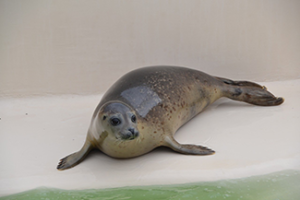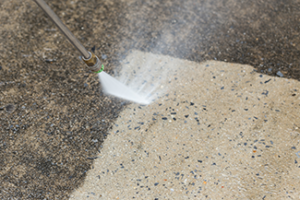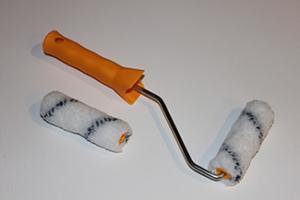DIY Sealing A Concrete Patio
The standard house comes complete with a concrete slab for the patio. Most people never do anything beyond sweeping the slab or the occasional power wash to remove barbeque, beverage, and pet stains. Left unprotected, stains, foot traffic, and UV rays can cause the concrete to fade and discolor.
 A simple way to protect the slab and enhance its appearance is to seal it.
A simple way to protect the slab and enhance its appearance is to seal it.
- Sealing repels moisture . If irrigation is near the slab, spalling (flaking concrete) can occur. It also prevents mold and mildew growth.
- Longer Lifespan – A sealed surface acquires less damage and makes added color fade-resistant and longer lasting.
- Enhance color and shine – There are many different types of sealers available from flat to high gloss. Select the level of shine.
Important consideration: Sealing a concrete patio can make the surface slippery. When wet, most sealers, especially high gloss, can be slippery. Add a fine abrasive to the sealer, experts in the field, like Tim McPherson, Excalibur Designs In Concrete Inc. adds silica flower or 120 grit sand to the sealer. He applies the sealer with a roller. His technique was mastered over time. “It’s not like painting a house,” he says. “It will add a bit of texture and help make the surface slip resistant.”
Concrete Patio and Concrete Network offer these suggestions for selecting a sealant and how to apply it.
Types of Sealants
The primary type of sealer used on decorative concrete patios is a solvent- or water-based acrylic. Acrylic sealers are easy to apply, inexpensive, and well-suited for outdoor use because they are UV resistant, non-yellowing, and provide good water repellence while allowing moisture vapor within the slab to escape.
If you don’t want a shiny surface, select a penetrating sealer. It will protect against outdoor exposure without forming a surface film.
 Chemically reactive sealers are nearly invisible because they penetrate the concrete, making them ideal for concrete patios. Water-based acrylic resin sealers will enhancement the color and provide a protective low-gloss satin finish. Solvent-based acrylic sealers and epoxies will give concrete a high-gloss wet look and significantly deepen the color. UV rays, depending on the exposure are hard on all these applications and the process will need to be repeated over time because of the Sun.
Chemically reactive sealers are nearly invisible because they penetrate the concrete, making them ideal for concrete patios. Water-based acrylic resin sealers will enhancement the color and provide a protective low-gloss satin finish. Solvent-based acrylic sealers and epoxies will give concrete a high-gloss wet look and significantly deepen the color. UV rays, depending on the exposure are hard on all these applications and the process will need to be repeated over time because of the Sun.
Let’s Get Seal
For a sealer to work, each step matters. Concrete Network takes us through the steps to properly apply a concrete sealer.
Preparing the Surface
For a sealer to properly adhere to the concrete, the surface must be free of dirt, oil stains, existing coatings, and any other substance that might inhibit sealer penetration. Newly placed concrete patios typically require very little preparation, if it has been exposed to the Sun. Existing surfaces may need to be power washed with soap and water and possibly etched chemically. You want your concrete to have some type of profile so the sealers will go into the concrete and adhere to the surface.
- Remove all oil, grease, stains, dirt, and dust from the concrete.
 Strip any existing sealer from the surface.
Strip any existing sealer from the surface.- Open up the concrete with an etching solution.
- Apply a thin coat of sealer using a roller or sprayer.
-
- Solvent-based sealers should be applied by spray. Water-based sealers are best applied by roller.
- If the patio is textured or stamped, be sure to use a roller with a thick nap so you can work it into the depressions. For sealing stamped or textured patios, spray first followed by back rolling to keep the sealer from settling in low spots.
- Achieve better results by applying the patio sealer in two thin coats. This will ensure more uniform coverage. If you apply the sealer too thickly, it will puddle rather than penetrate.
- Wait for the first layer of sealer to dry.
- Apply a second coat in the opposite direction.
- Allow the sealer to thoroughly dry before walking or placing objects on the surface.
IMPORTANT: Always follow the specific instructions recommended by the product manufacturer, as they may differ from the general guidelines given here.
In our dry climate, a concrete patio slab will need to be resealed every couple years or so.
Home Maintenance Calendar To-Do | #PatioSealing
Podcast
Tune-in! We cover our Weekly To Do on sealing a concrete patio. This project can be a DIY project but we caution and discuss the right and wrong methods to consider. Also, Becky, Owner of Rosie-Certified Arizona Chimney & Air Ducts details the proper inspections and cleaning for wood burning and gas fireplaces especially if it hasn’t been checked in a long time. Plus homeowner questions get answers!
###
Photo Credit
- Shutterstock
- Pixabay
















